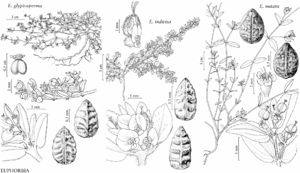Euphorbia indivisa
Proc. Biol. Soc. Wash. 48: 40. 1935.
Herbs, annual or short-lived perennial, with slender taproot to thickened and woody rootstock. Stems prostrate, usually mat-forming, terete to slightly flattened, 40 cm, lower surface glabrous, upper surface strigillose, pilose or villous. Leaves opposite; stipules distinct, entire or divided into 3–4 subulate to filiform segments, 0.8–2 mm, usually pilose, rarely glabrous; petiole 0.5–1 mm, pilose to villous; blade oblong, ovate or narrowly obovate, 3–10(–12) × 2–6 mm, base strongly asymmetric, hemicordate, margins serrulate, apex obtuse to subacute, surfaces glabrous or slightly pilose; 3-veined from base, often only midvein conspicuous. Cyathia usually in small cymose clusters on congested, axillary branches; peduncle rudimentary or to 0.2 mm. Involucre narrowly turbinate, 1–1.2 × 0.4–0.7 mm, pilose; glands 4, yellow to pink, unequal, proximal pair oblong or linear, 0.1 × 0.3–0.4(–0.6) mm, distal pair oblong or subcircular, 0.1 × 0.1–0.2 mm; appendages pink to reddish, unequal, on proximal glands oblique, 0.4–0.8(–1) × 0.8–1.4(–2) mm, on distal glands symmetric, 0.2–0.5 × 0.2–0.5 mm, slightly undulate to slightly crenate. Staminate flowers 5–15. Pistillate flowers: ovary pilose to strigillose in parts, glabrous in other parts; styles 0.8–1.3 mm, usually unbranched, rarely 2-fid at apex, filiform. Capsules ovoid-triangular, 1.2–1.5 × 1–1.4 mm, pilose to strigillose in parts, glabrous in other parts; columella 1–1.3 mm. Seeds brown to light gray, ovoid, 4-angled in cross section, 0.8–1 × 0.4–0.5 mm, with 4 or 5 deep transverse sulci alternating with low transverse ridges.
Phenology: Flowering and fruiting summer–fall.
Habitat: Grasslands, oak forests, oak-mesquite woodlands, oak-juniper communities, rarely entering desert scrub.
Elevation: 1000–2000 m.
Distribution

Ariz., N.Mex., Tex., Mexico.
Discussion
Euphorbia indivisa is characteristic of grasslands and oak woodlands from extreme western Texas to southeastern Arizona. The species is often treated as a synonym of E. dioeca Kunth, but the two species are readily separable on the basis of their seeds. The seeds of E. indivisa possess deep transverse sulci, whereas those of E. dioeca are merely rippled or with low transverse ridges. Euphorbia dioeca is a weedy species that occurs widely throughout tropical America but has yet to be encountered within the flora area.
Selected References
None.
